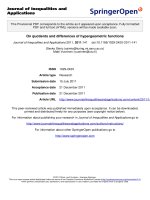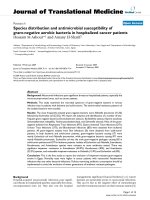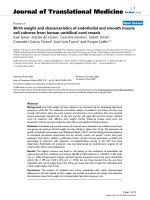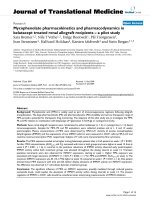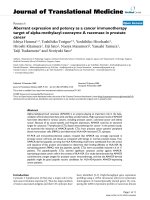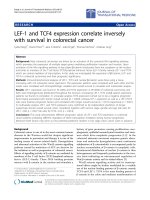Báo cáo hóa học: " Coefficient, distortion and growth inequalities for certain close-to-convex functions" docx
Bạn đang xem bản rút gọn của tài liệu. Xem và tải ngay bản đầy đủ của tài liệu tại đây (222.32 KB, 7 trang )
RESEARCH Open Access
Coefficient, distortion and growth inequalities for
certain close-to-convex functions
Nak Eun Cho
1*
, Oh Sang Kwon
2
and V Ravichandran
3,4
* Correspondence:
kr
1
Department of Applied
Mathematics, Pukyong National
University, Busan 608-737, South
Korea
Full list of author information is
available at the end of the article
Abstract
In the present investigation, certain subclasses of close-to-convex functions are
investigated. In particular, we obtain an estimate for the Fekete-Szegö functional for
functions belonging to the class, distortion, growth estimates and covering
theorems.
Mathematics Subject Classification (2010): 30C45, 30C80.
Keywords: starlike functions, close-to-convex functions, Fekete-Szegö inequalities,
distortion and growth theorems, subordination theorem
1 Introduction
Let
:= {z ∈ :| z |< 1}
be the open unit disk in the complex plane . Let
A
be the
class of analytic functions defined on
and normalized by the conditions f(0) = 0 and
f’ (0) = 1. Let
S
be the subclass of
A
consisting of univalent functions [1]. Sakaguchi
[2] introduced a class of functions called starlike functions with respect to symmetric
points; they are the functions
f ∈ A
satisfying the condition
Re
zf
(z)
f (z) −f (−z)
> 0.
These functions are close-to-convex functions. This can be easily seen by showing
that the functio n (f(z)-f(-z))/2isastarlikefunctionin
. Motivated by the class of
starlike functions with respect to symmetric points, Gao and Zhou [3] discussed a
class
K
s
of close-to-convex univalent functions. A function
f ∈ K
s
if it satisfies the
following inequality
Re
z
2
f
(z)
g(z)g(−z)
< 0(z ∈
)
for some function g Î S*(1/2) . The idea here is to replace the average of f(z) and - f
(-z) by the corresponding product -g(z) g(-z), and the factor z is included to normalize
the expression, so that -z
2
f’(z)/(g(z) g(-z)) takes the value 1 at z = 0. To make the func-
tions univalent, it is further as sumed that g is starlike of order 1/2 so that the function
-g( z) g(-z)/z is starlike, which in turn implies the close-to-convexity of f. For some
recent works on the problem, see [4-7]. Instead of requiring the quantity -z
2
f’(z)/(g(z)
g(-z)) to lie in the right-half plane, we can consider more general regions. This could
be done via subordination between analytic functions.
Cho et al. Journal of Inequalities and Applications 2011, 2011:100
/>© 2011 Cho et al; licensee Springer. This is an Open Access article distributed under the terms of the Creative Commons Attribution
License ( which permits unrestricted use, distribution, and reprod uction in any medium,
provided the original work is properly cited.
Let f and g be analytic in .Thenf is subordinate to g, written f ≺ g or
f (z) ≺ g(z)(z ∈ )
, if there is an analytic function w(z), with w(0) = 0 and |w(z)| < 1,
such that f(z)=g(w(z)). In particular, if g is univalent in
, then f is subordinate to g,
if f(0) = g(0) and
f ( ) ⊆ g( )
. In terms of subordination, a general class
K
s
(ϕ)
is
introduced in the following definition.
Definition 1 [4] For a function with positiv e real part, the class
K
s
(ϕ)
consists of
functions
f ∈ A
satisfying
−
z
2
f
(z)
g(z)g(−z)
≺ ϕ(z)(z ∈
)
(1)
for some function g Î S*(1/2).
This class was introduced by Wang et al. [4]. A special subclass
K
s
(γ ):=K
s
(ϕ)
where (z): = (1 + (1 - 2g) z )/(1 - z), 0 ≤ g < 1, was recently investigated by Kowalczyk
and Leś-Bomba [8]. They proved the sharp distortion and growth estimates for func-
tions in
K
s
(γ )
as well as some sufficient conditions in terms of the coefficient for
function to be in this class
K
s
(γ )
.
In the present investigation, we obtain a sharp estimate for the Fekete-Szegö func-
tional for functions belonging to the class
K
s
(ϕ)
. In addition, we also investigate the
corresponding problem for the inverse functions for functions belonging to the class
K
s
(ϕ)
. Also distortion, growth estimates as well as covering theorem are derived.
Some connection with earlier works is also indicated.
2 Fekete-Szegö inequality
In this section, we assume that the function (z) is an univalent analytic function with
positive real part that maps the unit disk
onto a starlike region which is symmetric
with respect to real axis and is normalized by ’(0) = 1 and (0) > 0. In such case, the
function has an expansion of the form (z)=1+B
1
z + B
2
z
2
+ , B
1
>0.
Theorem 1 (Fekete-Szegö Inequality) For a function f(z)=z + a
2
z
2
+ a
3
z
3
+
belonging to the class
K
s
(ϕ)
, the following sharp estimate holds:
| a
3
− μa
2
2
|≤1/3 + max(B
1
/3, | B
2
/3 − μB
2
1
/4 |)(μ ∈ ).
Proof Since the function
f ∈ K
s
(ϕ)
, there is a normalized analytic function g Î S*(1/
2) such that
−
z
2
f
(z)
g(z)g(−z)
≺ ϕ(z).
By using the definition of subordination between analytic function, we find a func-
tion w(z) analytic in
, normalized by w(0) = 0 satisfying |w(z)| < 1 and
−
z
2
f
(z)
g(z)g(−z)
= ϕ(w(z)).
(2)
By writing w(z)=w
1
z + w
2
z
2
+ , we see that
ϕ(w(z)) = 1 + B
1
w
1
z +(B
1
w
2
+ B
2
w
2
1
)z
2
+ ···.
(3)
Cho et al. Journal of Inequalities and Applications 2011, 2011:100
/>Page 2 of 7
Also by writing g(z)=z + g
2
z
2
+ g
3
z
3
+ , a calculation shows that
−
g(z)g(−z)
z
= z +(2g
3
− g
2
2
)z
3
+ ···
and therefore
−
z
g(z)g(−z)
=
1
z
− (2g
3
− g
2
2
)z
2
+ ···.
Using this and the Taylor’s expansion for zf’(z), we get
−
z
2
f
(z)
g(z)g(−z)
=1+2a
2
z +(3a
3
− 2g
3
+ g
2
2
)z
2
+ ···.
(4)
Using (2), (3) and (4), we see that
2a
2
= B
1
w
1
,
3a
3
=2g
3
− g
2
2
+ B
1
w
2
+ B
2
w
2
1
.
This shows that
a
3
− μa
2
2
=(2/3)(g
3
− g
2
2
/2) + (B
1
/3) (w
2
+(B
2
/B
1
− 3μB
1
/4)w
2
1
).
By using the following estimate ([9, inequality 7, p. 10])
| w
2
− tw
2
1
|≤ max{1; | t |} (t ∈ )
for an analyti c function w with w(0) = 0 and |w(z)| < 1 which is sharp for the func-
tions w(z)=z
2
or w(z)=z, the desired result follows upon using the estimate that
| g
3
− g
2
2
/2 |≤1/2
for analytic function g(z)=z + g
2
z
2
+ g
3
z
3
+ which is starlike of
order 1/2.
Define the function f
0
by
f
0
(z)=
z
0
ϕ(w)
1 − w
2
dw.
The function clearly belongs to the class
K
s
(ϕ)
with g(z)=z /(1 - z). Since
ϕ(w)
1 − w
2
=1+B
1
w +(B
2
+1)w
2
+ ···,
we have
f
0
(z)=z +(B
1
/2)z
2
+(1/3+B
2
/3)z
3
+ ···.
Similarly, define f
l
by
f
1
(z)=
z
0
ϕ(w
2
)
1 − w
2
dw.
Cho et al. Journal of Inequalities and Applications 2011, 2011:100
/>Page 3 of 7
Then
f
1
(z)=z +(B
1
/3+1/3)z
3
+ ···.
The functions f
0
and f
1
show that the results are sharp.
Remark 1 By setting μ = 0 in Theorem 1, we get the sharp estimate for the third
coefficient of functions in
K
s
(ϕ):
| a
3
|≤1/3 + (B
1
/3)max(1, | B
2
| /B
1
),
while the limiting case μ ® ∞ gives the sharp estimate |a
2
| ≤ B
1
/2. In the special
case where (z)=(1+z)/(1 - z), the results reduce to the corresponding one in [3,
Theorem 2, p. 125].
Though Xu et al. [7] have given an estimate of |a
n
| for all n, their result is not sharp
in general. For n = 2, 3, our results provide sharp bounds.
It is known that every univalent function f has an inverse f
-1
, defined by
f
−1
(f (z)) = z, z ∈
and
f (f
−1
(w)) = w,
| w | < r
0
(f ); r
0
(f ) ≥
1
4
.
Corol lary 1 Let
f ∈ K
s
(ϕ)
. Then the coefficie nts d
2
and d
3
of the inverse function f
-1
(w)=w + d
2
w
2
+ d
3
w
3
+ satisfy the inequality
| d
3
− μd
2
2
|≤1/3+max(B
1
/3, | B
2
/3 − (2 − μ)B
2
1
/4 |)(μ ∈ ).
Proof A calculation shows that the inverse function f
-1
has the following Taylor’s ser-
ies expansion:
f
−1
(w)=w − a
2
w
2
+(2a
2
2
− a
3
)w
3
+ ···.
From this expansion, it follows that d
2
= a
2
and
d
3
=2a
2
2
− a
3
and hence
| d
3
− μd
2
2
| = | a
3
− (2 −μ)a
2
2
| .
Our result follows at once from this identity and Theorem 1.
3 Distortion and growth theorems
The second coefficient o f univalent function plays an importa nt role in the theory of
univalent function; for example, this leads to the distortion and growth estimates for
univalent functions as well as the rotation theorem. In the next theorem, we derive the
distortion and growth estimates for the functions in the class
K
s
(ϕ)
. In particular, i f
we let r ® 1
-
in the growth estimate, it gives the bound |a
2
| ≤ B
1
/2 for the second
coefficient of functions in
K
s
(ϕ)
.
Theorem 2 Let be an analytic univalent functions with positive real part and
φ(−r) = min
|z |=r < 1
| φ( z ) |, φ(r)= max
|z |=r < 1
| φ( z ) | .
Cho et al. Journal of Inequalities and Applications 2011, 2011:100
/>Page 4 of 7
If
f ∈ K
s
(ϕ)
, then the following sharp inequalities hold:
ϕ(−r)
1+r
2
≤|f
(z) |≤
ϕ(r)
1 − r
2
(| z | = r < 1),
r
0
ϕ(−t)
1+t
2
dt ≤|f(z) |≤
r
0
ϕ(t)
1 − t
2
dt (| z | = r < 1).
Proof Since the function
f ∈ K
s
(ϕ)
, there is a normalized analytic function g Î S*(1/
2) such that
−
z
2
f
(z)
g(z)g(−z)
≺ ϕ(z).
(5)
Define the function
G : →
by the equation
G(z):=−
g(z)g(−z)
z
.
Then it is clear that G is odd starlike function in and therefore
r
1+r
2
≤|G(z) |≤
r
1 − r
2
(| z | = r < 1)
Using the definition of subordination between analytic function, and the Equation
(2), we see that there is an analytic function w(z) with |w(z)| ≤ |z| such that
zf
(z)
G(z)
= ϕ(w(z))
or zf’(z)=G(z) (w(z)). Since
w( ) ⊂
, we have, by maximum principle for harmo-
nic functions,
| f
(z) | =
| G(z) |
| z |
| ϕ(w(z)) |≤
1
1 − r
2
max
|z|=r
| ϕ(z) | =
ϕ(r)
1 − r
2
.
The other inequality for |f’ (z)| is similar. Since the function f is univalent, the
inequality for |f(z)| follows from the corresponding inequalities for |f’(z)| by Privalov’s
Theorem [10, Theorem 7, p. 67].
To prove the sharpness of our results, we consider the functions
f
0
(z)=
z
0
ϕ(w)
1 − w
2
dw, f
1
(z)=
z
0
ϕ(w)
1+w
2
dw.
(6)
Define the function g
0
and g
1
by g
0
(z)=z /(1 - z) and
g
1
(z)=z/
√
1+z
2
. These func-
tions are clearly starlike functions of order 1/2. Also a calculation shows that
−
z
2
f
k
(z)
g
k
(z)g
k
(−z)
= ϕ(z)(k =0,1).
Thus, the function f
0
satisfies the subordination (1) with g
0
, while the function f
1
sati sfies it with g
1
; therefore, these functions belong to the class
K
s
(ϕ)
.Itisclearthat
Cho et al. Journal of Inequalities and Applications 2011, 2011:100
/>Page 5 of 7
the upper estimates for |f’(z)| and |f(z)| are sharp for the function f
0
given in (6), while
the lower estimates are sharp for f
l
given in (6).
Remark 2 We note that Xu et al. [7] also obtained a similar estimates and our results
differ from thei r in the hypothesis. Also we have shown that the results are sharp. Our
hypothesis is same as the one assumed by Ma and Minda [11].
Rem ark 3 For the c hoice (z)=(1+z)/(1 - z), our result reduces to [3, Theorem 3,
p. 126], while for the choice (z)=(1+(1-2g)z)/(1 - z), it reduces to following esti-
mates (obtained in [8, Theorem 4, p. 1151]) for
f ∈ K
s
(γ ):
1 − (1 − 2γ )r
(1 + r)(1+r
2
)
≤|f
(z) |≤
1+(1− 2γ )r
(1 − r)(1− r
2
)
and
(1 − γ )ln
1+r
√
1+r
2
+ γ arctan r ≤|f(z) |≤
γ
2
ln
1+r
1 − r
+(1− γ )
r
1 − r
where | z|=r < 1. Also our result improves the corresponding results in [4].
Remark 4Let
k := lim
r→1−
r
0
ϕ(−t)/(1 + t
2
)dt
. Then the disk
{w ∈ : | w |≤k}⊆f ( )
for every
f ∈ K
s
(ϕ)
.
4 A subordination theorem
It is well known [12] that f is starlike if (1 - t) f( z) ≺ f(z)fort Î (0, Î), where Î is a
positive real number; also the function is starlike with respect to symmetric points if (1
- t) f(z)+tf(-z) ≺ f(z). In the following theorem, we extend these results to the class
K
s
. The proof of our result is based on the following version of a lemma of Stankie-
wicz [12].
Lemma 1 Let F(z, t) be analytic in
for each t Î (0, Î), F(z,0)=f(z),
f ∈ S
and F
(0, t)=0for each t Î (0, Î). Suppose that F(z, t) ≺ f(z) and that
lim
t→0
+
F( z , t) −f (z)
zt
ρ
= F(z)
exists for some r >0.If F is analytic and Re (F(z)) ≠ 0, then
Re
F( z )
f
(z)
< 0.
Theorem 3 Let
f ∈ S
and
g ∈ S
∗
(1/2). Let Î >0and f(z)+tg(z)g(-z)/z ≺ f(z), t Î (0,
Î). Then
f ∈ K
s
.
Proof Define the function F by F(z, t)=f(z)+tg(z)g(-z)/z.ThenF(z, t)isanalyticfor
every fixed t and F(z,0)=f(z) and by our assumption,
f ∈ S
. Also
lim
t→0
+
F( z , t) −f (z)
zt
=
g(z)g(−z)
z
2
:= F(z).
The function F is analytic in (of course, one has to redefine the function F at z =
0 where it has removable singularity.) Since all hypotheses of Lemma 1 are satisfied,
we have
Cho et al. Journal of Inequalities and Applications 2011, 2011:100
/>Page 6 of 7
Re
g(z)g(−z)
z
2
f
(z)
< 0.
Sinceafunctionp(z) has negative real part if and only if its reciprocal 1/p(z)has
negative real part, we have
Re
z
2
f
(z)
g(z)g(−z)
< 0.
Thus,
f ∈ K
s
.
Acknowledgements
The first author was supported by the Basic Science Research Program through the National Research Foundation of
Korea (NRF) funded by the Ministry of Education, Science and Technology (no. 2011-0007037).
Author details
1
Department of Applied Mathematics, Pukyong National University, Busan 608-737, South Korea
2
Department of
Mathematics, Kyungsung University, Busan 608-736, South Korea
3
Department of Mathematics, University of Delhi,
Delhi 110007, India
4
School of Mathematical Sciences, Universiti Sains Malaysia, 11800 USM Penang, Malaysia
Authors’ contributions
All authors jointly worked on the results and they read and approved the final manuscript.
Competing interests
The authors declare that they have no competing interests.
Received: 24 June 2011 Accepted: 27 October 2011 Published: 27 October 2011
References
1. Duren, PL: Univalent functions. In Grundlehren der Mathematischen Wissenschaften, vol. 259,Springer, New York (1983)
2. Sakaguchi, K: On a certain univalent mapping. J Math Soc Japan. 11,72–75 (1959). doi:10.2969/jmsj/01110072
3. Gao, C, Zhou, S: On a class of analytic functions related to the starlike functions. Kyungpook Math J. 45(1), 123–130
(2005)
4. Wang, Z, Gao, C, Yuan, S: On certain subclass of close-to-convex functions. Acta Math Acad Paedagog Nyházi (N. S.)
22(2), 171–177 (2006). (electronic)
5. Wang, ZG, Chen, DZ: On a subclass of close-to-convex functions. Hacet J Math Stat. 38(2), 95–101 (2009)
6. Wang, ZG, Gao, CY, Yuan, SM: On certain new subclass of close-to-convex functions. Mat Vesnik. 58(3-4), 119–124 (2006)
7. Xu, QH, Srivastava, HM, Li, Z: A certain subclass of analytic and close-to-convex functions. Appl Math Lett. 24(3),
396–401 (2011). doi:10.1016/j.aml.2010.10.037
8. Kowalczyk, J, Leś-Bomba, E: On a subclass of close-to-convex functions. Appl Math Lett. 23(10), 1147–1151 (2010).
doi:10.1016/j.aml.2010.03.004
9. Keogh, FR, Merkes, EP: A coefficient inequality for certain classes of analytic functions. Proc Amer Math Soc. 20,8–12
(1969). doi:10.1090/S0002-9939-1969-0232926-9
10. Goodman, AW: Univalent functions. Mariner Publishing Co. Inc., Tampa, FLI (1983)
11. Ma, WC, Minda, D: A unified treatment of some special classes of univalent functions. In Proceedings of the Conference
on Complex Analysis (Tianjin, 1992), Conference Proceedings Lecture Notes Analysis, vol. I, pp. 157–169.International
Press, Cambridge, MA (1994)
12. Stankiewicz, J: Some remarks on functions starlike with respect to symmetric points. Ann Univ Mariae Curie-Sklodowska
Sect A. 19,53–59 (1970)
doi:10.1186/1029-242X-2011-100
Cite this article as: Cho et al.: Coefficient, distortion and growth inequalities for certain close-to-convex
functions. Journal of Inequalities and Applications 2011 2011:100.
Cho et al. Journal of Inequalities and Applications 2011, 2011:100
/>Page 7 of 7
